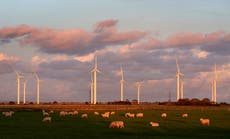New analysis says ‘energy security starts at home’, as cabinet rows hold up PM’s ‘independence plan’
Rob Merrick
Deputy Political Editor
THE INDEPENDENT
How To Keep Your Energy Bills Low
Fixing energy-leaking homes and funding wind projects – not nuclear power stations – is key to weaning the UK off Russian gas, a new study says, amid cabinet clashes over policy.
Boris Johnson is pushing to get 25 per cent of the UK’s electricity from nuclear power – requiring up to six new power stations – at a cost that is alarming Rishi Sunak, the chancellor.
Meanwhile, cabinet rows over relaxing planning rules to lift the block on onshore wind turbines are also holding up a new energy strategy, prompted by the Ukraine crisis.
Now an analysis by the climate change think tank E3G says a strategy that “starts at home” is the route to reducing reliance on Vladimir Putin’s gas supplies.
Dramatically improving the energy efficiency of the UK’s buildings “could secure an 80 per cent cut in the amount of gas we import from Russia this year”, it is arguing.
If combined with government funding for solar and onshore wind projects already in the planning pipeline, “the UK could cut the amount of gas we get from Russia by 100 per cent within a year”.
“Energy security starts at home,” said Ed Matthew, E3G’s campaigns director, ahead of the expected release of the “energy independence plan” this week.
“By ramping up the energy efficiency of UK buildings and accelerating renewables deployment, the government can take an axe to UK gas demand.
“Not only can this help cut household bills, it is the single most effective action the government can take to protect UK and European energy security.”
E3G is pointing out that a war-torn Ukraine managed to “unplug from Russia’s electricity grid” within a fortnight, adding: “We should take inspiration from Ukraine’s power engineers.”
The government has made little effort to target home energy efficiency, after the shambolic failure of the Green Homes Grant voucher scheme.
Instead, Mr Johnson wants to focus on reviving nuclear power, with a mix of big plants and small modular reactors (SMRs), which are easier and cheaper to build.
However, the National Infrastructure Commission has warned that large nuclear power plants are “incredibly difficult to deliver on short timescales”.
Even if the government gave the go-ahead now, they would not come online until the mid-2040s if they took as long as the current Hinkley Point C project is expected to take.
The prime minister’s view on onshore wind is mired in confusion, after he appeared to come out against an expansion when speaking to MPs last week.
Despite that, the strategy is expected to trigger a review of the effective moratorium imposed by planning laws introduced under David Cameron’s government.
Instead, Mr Johnson wants to focus on reviving nuclear power, with a mix of big plants and small modular reactors (SMRs), which are easier and cheaper to build.
However, the National Infrastructure Commission has warned that large nuclear power plants are “incredibly difficult to deliver on short timescales”.
Even if the government gave the go-ahead now, they would not come online until the mid-2040s if they took as long as the current Hinkley Point C project is expected to take.
The prime minister’s view on onshore wind is mired in confusion, after he appeared to come out against an expansion when speaking to MPs last week.
Despite that, the strategy is expected to trigger a review of the effective moratorium imposed by planning laws introduced under David Cameron’s government.
Kwasi Kwarteng, the business secretary, has proposed doubling onshore wind turbine power from 14 gigawatts to 30GW by 2030, with the bulk of new projects in Scotland.
He is also said to be pushing for the government to go further to hit a target of 45GW of energy from offshore wind by 2035.
Recommended

He is also said to be pushing for the government to go further to hit a target of 45GW of energy from offshore wind by 2035.
Recommended


No comments:
Post a Comment